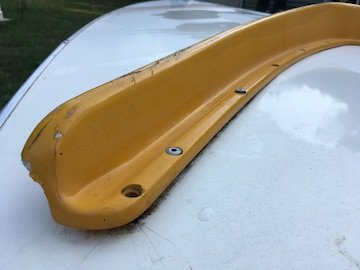don44
Member
I recently acquired a 1980 Sunfish in nice shape except for the splashboard (coaming), which seems to be warping and pulling itself up off the deck on the two ends. On one end the OEM pop rivets (Rivnuts) have pulled out of the deck and are loose. The deck seems to be in great shape, with no spider cracks, etc., except at the ends of the coaming. Is this a common problem? I suppose I could drill out the loose rivets on the ends and replace them but I wonder if the splashboard warpage would cause undesired pressure on the deck. Any ideas on how to accomplish proper repair? Should I use another (better) type of fastener?
Attachments
Last edited:






 Now I see you mean to attach the assembly ON TOP of the deck
Now I see you mean to attach the assembly ON TOP of the deck  . I'd measure twice, do one side then the other, but that's a great suggestion IMHO.
. I'd measure twice, do one side then the other, but that's a great suggestion IMHO. 